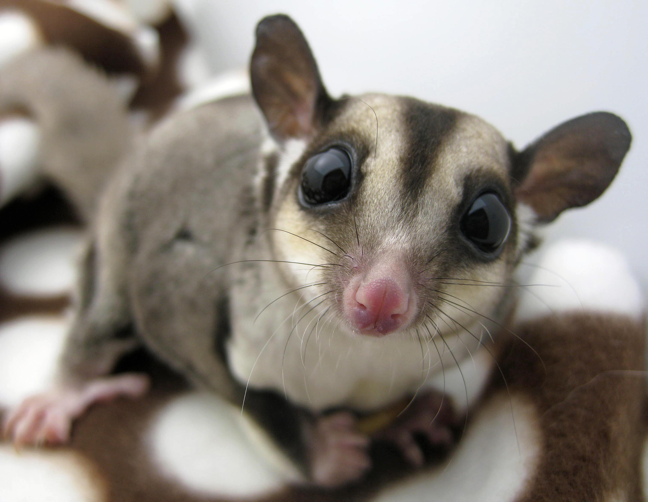
A Comprehensive Guide to Nurturing and Caring for Baby Sugar Gliders
Sugar gliders, with their adorable appearance and captivating personalities, have become increasingly popular as exotic pets. These nocturnal marsupials, native to Australia and New Guinea, require specialized care and attention, especially during their vulnerable infancy. This comprehensive guide will provide you with all the essential knowledge and practical tips to ensure the well-being and thriving of your baby sugar glider.
1. Establishing a Suitable Habitat
- Enclosure: Provide a spacious enclosure that allows for ample movement and exploration. A cage with multiple levels, hiding places, and climbing structures is ideal.
- Temperature and Humidity: Sugar gliders thrive in a warm and humid environment. Maintain a temperature of 75-85°F (24-29°C) and a humidity level of 50-60%.
- Bedding: Line the enclosure with soft and absorbent bedding materials such as fleece, shredded paper, or aspen shavings. Avoid using cedar or pine shavings, as they can be harmful to sugar gliders.
- Hiding Places: Provide multiple hiding places within the enclosure, such as pouches, nesting boxes, or tunnels. This creates a sense of security and comfort for the baby glider.
2. Nutrition and Feeding
- Diet: Baby sugar gliders require a specialized diet consisting of:
- Milk: Offer a commercial sugar glider milk formula or a mixture of goat’s milk and water. Feed every 2-3 hours for the first few weeks, gradually increasing the interval as the glider grows.
- Protein: Introduce small amounts of live insects, such as crickets or mealworms, once the glider is around 6 weeks old.
- Fruits and Vegetables: Offer a variety of fresh fruits and vegetables, such as apples, bananas, blueberries, and sweet potatoes.
- Feeding Method: Use a syringe or bottle to feed the baby glider. Hold the glider upright and gently insert the syringe or bottle into its mouth. Avoid overfeeding, as this can lead to digestive issues.
3. Hygiene and Grooming
- Bathing: Sugar gliders do not require regular baths. However, if necessary, use lukewarm water and a mild, unscented soap. Rinse thoroughly and dry the glider with a soft towel.
- Nail Trimming: Trim the glider’s nails regularly to prevent overgrowth. Use sharp nail clippers and be careful not to cut too close to the quick.
- Ear Cleaning: Check the glider’s ears for any signs of infection or debris. If necessary, use a cotton swab dipped in a gentle ear cleaning solution to gently clean the ears.
4. Socialization and Handling
- Socialization: Sugar gliders are social animals and require regular interaction. Handle the baby glider frequently, starting from a young age. This will help it become accustomed to human contact and reduce stress.
- Handling: When handling the baby glider, support its body with one hand and gently hold its tail with the other. Avoid holding the glider by its neck or tail.
- Bonding: Spend quality time with the baby glider, talking to it and offering treats. This will help establish a strong bond between you and your pet.
5. Health and Veterinary Care
- Regular Checkups: Take the baby glider to a veterinarian experienced in exotic animals for regular checkups. This will ensure its overall health and detect any potential health issues early on.
- Vaccinations: Sugar gliders should be vaccinated against common diseases, such as parvovirus and distemper. Consult with your veterinarian for a vaccination schedule.
- Common Health Issues: Baby sugar gliders are susceptible to certain health issues, including:
- Hypothermia: Keep the glider warm and avoid exposing it to cold temperatures.
- Diarrhea: Feed the glider a balanced diet and ensure it has access to clean water.
- Respiratory Infections: Maintain a clean enclosure and avoid exposing the glider to drafts or smoke.
6. Enrichment and Stimulation
- Toys: Provide a variety of toys to keep the baby glider entertained and stimulated. This can include toys that encourage climbing, foraging, and exploration.
- Foraging: Hide treats or insects around the enclosure to encourage the glider’s natural foraging instincts.
- Exercise: Allow the baby glider to explore outside of its enclosure under supervision. This provides it with opportunities for exercise and socialization.
7. Special Considerations
- Weaning: Gradually wean the baby glider from milk to solid foods between 8-12 weeks of age. Start by offering small amounts of insects and fruits and vegetables, and gradually reduce the frequency of milk feedings.
- Sexing: Determining the sex of a baby sugar glider can be challenging. It is best to consult with a veterinarian or experienced breeder for accurate sexing.
- Companionship: Sugar gliders are social animals and should not be kept alone. Consider getting a companion glider of the same sex to provide companionship and enrichment.
Conclusion
Caring for a baby sugar glider is a rewarding experience that requires dedication, patience, and a deep understanding of their unique needs. By following the comprehensive guidelines outlined in this article, you can provide your baby sugar glider with the optimal environment, nutrition, and care it needs to thrive and flourish. Remember to seek professional veterinary advice whenever necessary to ensure the well-being and longevity of your beloved pet.
